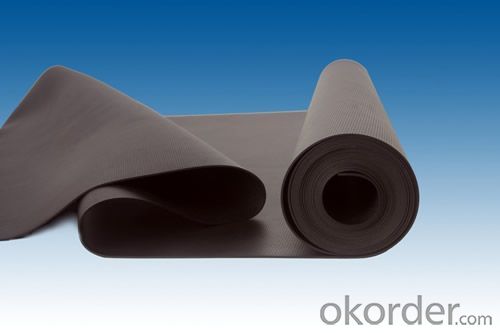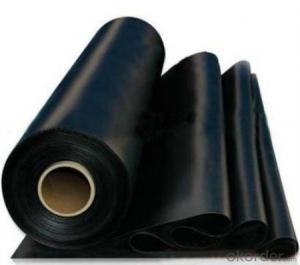Membrane EPDM Vulcanization 1.5mm for Waterproof System
- Loading Port:
- Qingdao
- Payment Terms:
- TT OR LC
- Min Order Qty:
- 12000 m²
- Supply Capability:
- 100000 m²/month
OKorder Service Pledge
OKorder Financial Service
You Might Also Like
EPDM Membrane Vulcanization for Waterproof System
Description Of EPDM Membrane Vulcanization1.5mm:
1. EPDM membrane is made from ternary ethylene-propylene rubber, which is for waterproofing of exposed and non-exposed applications.
2. EPDM membrane production adopts the world-advanced equipment of cold feeding extrusion and continuous vulcanization technology.
Main Features of EPDM Vulcanization1.5mm:
1. Excellent physical and mechanical performance
2. High tearing resistance
3. Good deformation adaptability
Specifications of EPDM Vulcanization1.5mm:
Material | Ternary Ethylene-Propylene rubber |
Size | 1.2m (width)*20m (length) or customized, weldable type 2.05m or 4m width |
Type | Vulcanized |
Applications of EPDM Rubber Vulcanization1.5mm:
1.Roofs, Basement, Toilets
2. Industrial and civil building waterproofing
IMages of EPDM Vulcanization1.5mm:


FAQ:
1. What are we supplying?
We are specialized in producing Colorful Asphalt Roof Shingle, SBS/APP modified bitumen waterproof membrane, Self adhesive bitumen waterproof membrane, PVC waterproofing membrane,Single Component Polyurethane Waterproof Coating, and Spray Polyurea Waterproof Coating
.
2. How Many years experience do we have?
We have been exported to more than 15 countries in the past 10 years.
3. How long do we usually reply your request?
We always reply our customer within 12 hours.
- Q:Are waterproofing membranes resistant to oil and fuel spills?
- Yes, waterproofing membranes are generally resistant to oil and fuel spills. These membranes are specifically designed to create a barrier that prevents water or any other liquid from penetrating through them, including oil and fuel. They are often made from materials such as polyurethane or PVC, which have excellent resistance to various chemicals, including oil and fuel. This makes them suitable for applications where there is a possibility of oil or fuel spills, such as parking garages, industrial facilities, or areas where vehicles are present. However, it is essential to note that the level of resistance may vary depending on the specific type and quality of the membrane used. Therefore, it is crucial to choose a high-quality and appropriate waterproofing membrane that meets the specific requirements of the project to ensure long-term resistance to oil and fuel spills.
- Q:Can a waterproofing membrane be used for tunnels or underground structures?
- Yes, a waterproofing membrane can be used for tunnels or underground structures. Waterproofing membranes are specifically designed to prevent the ingress of water and protect structures from moisture damage. Tunnels and underground structures are often exposed to groundwater or high levels of moisture, making waterproofing essential to maintain their integrity and durability. The waterproofing membrane is applied to the exterior surface of the tunnel or underground structure, creating a barrier that prevents water penetration. It acts as a protective layer, preventing water from seeping through the walls, roof, or floor. There are various types of waterproofing membranes available, including bituminous, polyurethane, and cementitious membranes. Each type offers different properties and advantages depending on the specific requirements of the project. In addition to preventing water infiltration, waterproofing membranes also provide protection against other potential issues such as corrosion, mold growth, and structural damage. They help to extend the lifespan of the tunnel or underground structure and reduce maintenance and repair costs. It is important to ensure that the waterproofing membrane is properly installed by qualified professionals to ensure its effectiveness. Regular inspections and maintenance are also crucial to identify any potential issues and address them promptly. Overall, a waterproofing membrane is a highly effective solution for tunnels and underground structures, providing long-lasting protection against water damage and ensuring their structural integrity.
- Q:Can a waterproofing membrane be used for seawalls or bulkheads?
- Yes, a waterproofing membrane can be used for seawalls or bulkheads. Waterproofing membranes are designed to provide a barrier against water penetration and can be applied to various structures, including seawalls and bulkheads. These membranes are typically made of materials such as bitumen, rubber, PVC, or polyurethane, which offer excellent resistance to water and ensure the structural integrity of the wall or bulkhead. The membrane is applied to the surface of the structure, forming a continuous and durable waterproof layer that prevents water from seeping through. This helps protect the seawall or bulkhead from erosion, corrosion, and other forms of damage caused by exposure to seawater. Additionally, waterproofing membranes can also provide additional benefits such as increased durability, improved aesthetics, and enhanced resistance to UV rays and chemicals. Overall, the use of a waterproofing membrane is an effective solution for ensuring the long-term performance and durability of seawalls and bulkheads in marine environments.
- Q:Can a waterproofing membrane be used for below-grade parking garages?
- Yes, a waterproofing membrane can be used for below-grade parking garages. Waterproofing membranes are commonly used in construction projects to prevent the ingress of water into the structure. In below-grade parking garages, where the structure is below ground level, the risk of water infiltration is higher. Therefore, using a waterproofing membrane is an effective solution to protect the parking garage from water damage and ensure its durability.
- Q:Are waterproofing membranes suitable for high-traffic areas?
- Yes, waterproofing membranes are suitable for high-traffic areas. Waterproofing membranes are designed to provide a protective barrier against water infiltration, preventing water damage and maintaining the integrity of the structure. High-traffic areas, such as walkways, driveways, parking lots, and other heavily used spaces, are prone to constant exposure to water, which can lead to structural damage and deterioration over time. By applying a waterproofing membrane, these areas can be effectively protected from water intrusion, ensuring their durability and longevity. Additionally, waterproofing membranes are often designed to be slip-resistant, providing an added safety feature in high-traffic areas. Therefore, using waterproofing membranes in high-traffic areas is a wise choice to mitigate water-related issues and maintain the structural integrity of the space while ensuring the safety of occupants.
- Q:Can a waterproofing membrane be installed on metal surfaces?
- Yes, a waterproofing membrane can be installed on metal surfaces. There are various types of waterproofing membranes available, including those specifically designed for metal substrates. These membranes are often made of materials such as PVC, TPO, or EPDM, which are flexible and can adhere well to metal surfaces. The installation process typically involves cleaning and preparing the metal surface, applying a primer if necessary, and then applying the waterproofing membrane using adhesive or heat welding techniques. This provides a protective barrier against water infiltration and helps to prevent corrosion and damage to the metal surface. It is important to ensure that the chosen waterproofing membrane is compatible with the specific type of metal being used and that proper installation procedures are followed to achieve effective waterproofing.
- Q:How does a waterproofing membrane handle exposure to chemicals or solvents?
- A waterproofing membrane is designed to provide protection against water and moisture. However, its resistance to chemicals or solvents depends on the type of membrane used. There are different types of waterproofing membranes available in the market, each with its own set of properties and capabilities. Some waterproofing membranes are specifically manufactured to withstand exposure to chemicals or solvents. These membranes are typically made from materials such as PVC (polyvinyl chloride), TPO (thermoplastic olefin), or CPE (chlorinated polyethylene). These materials offer excellent chemical resistance, making the membranes highly effective in environments where exposure to chemicals or solvents is expected. On the other hand, some waterproofing membranes may not be as resistant to chemicals or solvents. For instance, membranes made from bitumen or asphalt may be susceptible to degradation or damage when exposed to certain chemicals or solvents. In such cases, additional protective measures may be required, such as using a chemical-resistant coating or providing a secondary barrier to prevent direct contact between the membrane and the chemicals or solvents. It is important to consider the specific requirements of the project and the potential exposure to chemicals or solvents when selecting a waterproofing membrane. Consulting with a professional waterproofing contractor or manufacturer can help determine the most suitable membrane for the intended application. Regular inspections, maintenance, and proper cleaning of the membrane are also crucial to ensure its longevity and performance when exposed to chemicals or solvents.
- Q:Can a waterproofing membrane be used for concrete tank linings?
- Concrete tank linings can make use of waterproofing membranes, which are frequently employed in construction to obstruct water penetration and offer a protective shield. By applying a waterproofing membrane to the inner surfaces of a concrete tank, the infiltration of water and subsequent harm can be effectively averted. This becomes especially crucial for tanks that store fluids or chemicals, as any leakage can result in contamination or structural decay. By utilizing a waterproofing membrane, the tank can be shielded against water ingress, guaranteeing its durability and preserving its structural soundness.
- Q:Can waterproofing membranes be used on retaining walls?
- Yes, waterproofing membranes can be used on retaining walls. Waterproofing membranes are commonly used on retaining walls to prevent water infiltration and protect the structure from moisture-related issues such as seepage, efflorescence, and cracking. These membranes act as a barrier that prevents water from penetrating the retaining wall and causing damage. They are typically installed on the exterior side of the retaining wall, providing an additional layer of protection against water intrusion. Waterproofing membranes come in various forms, such as sheet membranes, liquid-applied membranes, and cementitious coatings, and can be chosen based on the specific needs and requirements of the retaining wall.
- Q:Can a waterproofing membrane be used on brass surfaces?
- A waterproofing membrane is typically used to protect surfaces from water penetration and damage. While brass surfaces are not typically prone to water damage, a waterproofing membrane can still be used as an additional protective layer. It can help prevent moisture build-up on the brass surface, which can eventually lead to tarnishing or corrosion. However, it is important to note that brass surfaces are often desired for their natural patina and aesthetic appeal. Applying a waterproofing membrane may alter the appearance of the brass, potentially creating a glossy or artificial finish. Therefore, it is advisable to carefully consider the desired outcome before deciding to use a waterproofing membrane on brass surfaces.
1. Manufacturer Overview |
|
|---|---|
| Location | |
| Year Established | |
| Annual Output Value | |
| Main Markets | |
| Company Certifications | |
2. Manufacturer Certificates |
|
|---|---|
| a) Certification Name | |
| Range | |
| Reference | |
| Validity Period | |
3. Manufacturer Capability |
|
|---|---|
| a)Trade Capacity | |
| Nearest Port | |
| Export Percentage | |
| No.of Employees in Trade Department | |
| Language Spoken: | |
| b)Factory Information | |
| Factory Size: | |
| No. of Production Lines | |
| Contract Manufacturing | |
| Product Price Range | |
Send your message to us
Membrane EPDM Vulcanization 1.5mm for Waterproof System
- Loading Port:
- Qingdao
- Payment Terms:
- TT OR LC
- Min Order Qty:
- 12000 m²
- Supply Capability:
- 100000 m²/month
OKorder Service Pledge
OKorder Financial Service
Similar products
New products
Hot products
Related keywords






























